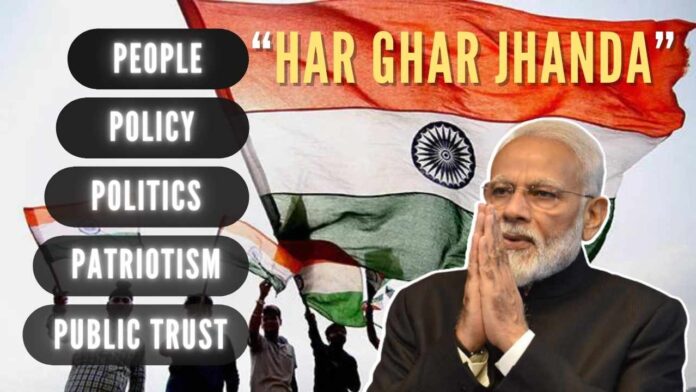
One of the game-changing initiatives – “Har Ghar Jhanda”
India as a nation, first and foremost, belongs to her people. They expect and deserve that India’s governance be modelled by the will of the people in the best interest of the people. As India celebrates the historic 75th anniversary of independence dubbed, “Azadi Ka Amrit Mahotsav,” one of its game-changing initiatives is “Har Ghar Jhanda (HGJ).”
This article includes a discussion about what and why HGJ and how it is impacting the people, policy, and politics, and building patriotism and public trust. It is a snapshot of HGJ rekindling the spirit of nationalism among the masses while creating a classical syndrome of opposition political parties engaged in innuendos against the ruling BJP led by Prime Minister Modi. For many others, not surprisingly, it is arousing religious strife and anti-national activism.
People and patriotism
The unprecedented HGJ, the tricolor at each home, is a timely and timeless effort to raise awareness about the national flag and invoke feelings of patriotism in the hearts of people[1]. In this phrase, the people and patriotism are the keywords. People, as we said before, constitute the soul of India and deserve to fully appreciate, understand, and celebrate the national flag more than just symbolically. The ground reality is that in the past a very small percentage of people participated in the flag ceremony on national days like August 15 and January 26. It is better late than never and very fitting to call for HGJ with the 75th anniversary of India’s independence.
The ‘patriotism’ is what is causing consternation, heartache, and stomachache among the religious bigots who live and breathe in India with their hearts and loyalties elsewhere. These anti-national individuals and/ or people of anti-Hindu mindset should have long been ousted from India. The new India has been very tolerant of the anti-national and/ or unpatriotic activists upholding the secular nature of the Constitution. The time is now that all citizens respect and honor the sanctity of Tiranga even if they don’t want to participate in HGJ, otherwise their citizenship should be called into question.
The policy
The 2002 Flag Code governed the use, display, and hoisting of the tricolor. Recently, it was amended to include flag hoisting by a member of the public, private organizations, and educational institutions on all days through day and night (instead of only sunrise to sunset). The Code now reads, “where the flag is displayed in open or displayed on the house of a member of the public, it may be flown day and night“[2].
Additionally, the Code now includes machine-made and polyester flags to meet the expected huge demand for HGJ. It now reads, “The national flag shall be made of hand spun and hand woven or machine made, cotton/ polyester/ wool/ silk khadi bunting.” However, the Code retained that dignity and honor must not be compromised. It is a welcome policy change in good faith and to meet the needs of changing times i.e., connecting the people of India to the national flag not only symbolically but as an embodiment of everyone’s commitment to nation-building.
The politics
The change in the Code did not go unchallenged by the politicians and those who can be safely branded anti-national and unpatriotic. The Congress and its dynastic leadership for more than six decades could not stomach the lack of their own vision to promote the HGJ-like initiative at the 50th anniversary or sooner. Another political party leader questioned the GST on flags and reportedly there is none[3][4].
Congress is screaming that India is importing flags from China which is far from the truth according to another report[5][6]. The Congress is accusing the Modi government to move away from the home-spun fabric for the flags and taking the livelihood from the weavers. The truth however is that many Self-Help Groups (SHGs) in the villages are engaged and empowered to make flags to meet the huge demand[6]. There was no way that the weavers could meet the growing demand. Reportedly, no flags are being imported from China, and HGJ, in fact, is providing employment to many more and making SHGs proud in nation building. I surmise that HGJ is the best thing with a strong potential to succeed in its mission of connecting the hearts and minds of people with Tiranga.
It is also unprecedented that India’s postal department sold more than one crore flags at a nominal cost of Rs.25 through its network of post offices across India[7]. Additionally, the online sale of Tiranga is underway to satisfy the changing needs and attitudes of professionals who prefer shopping from the comfort of their homes. Both ideas are creative in reaching people even in the remotest areas to the digitally trained population. Anyone getting the mail delivered has had access to the flag, if desired.
Public trust
Another nationwide network of government schools in every village is a conduit for raising awareness and creating public trust. First, the children in schools are being strongly encouraged and engaged in the mission of HGJ. More importantly, their parents and thus the larger community in the villages are connecting with HGJ. As a co-founder of Vidya Gyan, an NGO supporting rural government schools, I know firsthand how vigorously the schools in U.P. are promoting HGJ.
Undeniably, school children are India’s future. If HGJ succeeds in raising awareness about the national flag and invoking feelings of patriotism in children’s hearts, the nation has made a lasting impact. I am also very confident that crores of people will be part of HGJ for the first time. It is only a matter of days to know about the success of HGJ.
In conclusion, the public trust in new India will receive a significant boost with Modi’s HGJ initiative, yet another strike against the political parties. It is also Modi’s path toward building a stronger and sustainable patriotic India with Sab ka Saath, Prayas, aur Vishwas.
Note:
1. Text in Blue points to additional data on the topic.
2. The views expressed here are those of the author and do not necessarily represent or reflect the views of PGurus.
Reference:
[1] Ghar Ghar Tricolour: This August 15, Govt Wants Every House To Hoist National Flag – Jun 16, 2022, India Times
[2] Explained: What is the Flag Code of India? What changes has the Centre made? – Jul 25, 2022, Firstpost
[3] ‘How much GST will be paid on national flag’: Akhilesh Yadav’s question akhilesh yadav asked how much gst will have to be paid on the flags told by bjp – News in Gujarati – Gujarati Newspaper – Gujarati News CB News – Aug 7, 2022, Crazy Bollywood
[4] Finance Ministry announces GST exemption on sale of national flag – Jul 09, 2022, Livemint
[5] Flags being imported from China for ‘Har Ghar Tiranga’ initiative: Maha Congress chief – Aug 10, 2022, Telegraph India
[6] Andhra Pradesh: National flags not being imported from China, clarifies OSD to Kishan Reddy – Aug 03, 2022, The Hindu
[7] Har Ghar Tiranga: Department of Posts sells over one crore Indian national flags in 10 days – Aug 12, 2022, Firstpost
PGurus is now on Telegram. Click here to join our channel and stay updated with all the latest news and views
For all the latest updates, download PGurus App.
- Education and election in Bharat: Race to the top - April 16, 2024
- Kejriwal: “An Insignificant Man” or a corrupt politician with impending prison term - March 24, 2024
- Bharat’s general elections and the Model Code of Conduct - March 22, 2024










